Column Penetration and Diffusion Mechanism of Bingham Fluid Considering Displacement Effect
Abstract
:1. Introduction
2. Penetration and Diffusion Equation of Bingham Fluid
2.1. Basic Assumptions
2.2. Penetration Motion Equation
3. Column Permeation Diffusion Model of Bingham Fluid
4. Comparison between the Theoretical and Experimental Results
5. Analysis of Displacement Effect
5.1. Pressure Distribution in Grout Diffusion Zone
5.2. Analysis of the Influence Factors
- (1)
- With the increase in grouting time, the diffusion radius obtained by the two theoretical models increases nonlinearly with time. The increment speed of diffusion radius gradually decreases with time. The increment of diffusion radius in the early period is much larger than that in the late period.
- (2)
- The grouting pressure, groundwater pressure, water-cement ratio of Bingham cement grout and penetration coefficient of porous media significantly affect the diffusion radius under the two theoretical models. The relationship between groundwater pressure and diffusion radius is reverse. The greater the groundwater pressure, the smaller the diffusion radius. However, the grouting pressure, penetration coefficient of porous media and water–cement ratio are positively associated with the diffusion radius of Bingham cement grout. The greater the grouting pressure, porous media penetration coefficient and water–cement ratio of Bingham cement grout, the greater the diffusion radius.
6. Numerical Simulation
6.1. Development of the Numerical Model
6.2. Numerical Simulation Results
7. Conclusions
- (1)
- Based on the rheological equation and the steady-state column penetration continuity equation of Bingham fluid, the column penetration diffusion mechanism of Bingham fluid considering the displacement effect is proposed. Compared with the existing penetration grouting experiments, the grout diffusion radius obtained by the penetration grouting mechanism of Bingham fluid considering the displacement is closer to the experimental value than that of Bingham fluid without considering the displacement effect.
- (2)
- The influence of the groundwater pressure on the grout diffusion radius considering the displacement effect in the grout diffusion process is more obvious than that without considering the influence of the displacement effect. The larger the grouting pressure, penetration coefficient of porous media and water–cement ratio of grout, the larger the diffusion radius of grout.
- (3)
- Using computer programming technology and the Comsol Multi-physics platform, a three-dimensional numerical simulation program for the penetration grouting mechanism of Bingham fluid, considering and without considering the displacement, is obtained. The rationality of the simulation program is verified with model experiments, which can provide support for grouting construction design.
Author Contributions
Funding
Institutional Review Board Statement
Informed Consent Statement
Data Availability Statement
Acknowledgments
Conflicts of Interest
References
- Wang, G. Theory and Practice of Grouting Technology; China University of Mining and Technology Press: Xuzhou, China, 2000. (In Chinese) [Google Scholar]
- Yang, Z.; Ding, Y.; Zhu, Y.; Zhang, J.; Guo, Y.; Chen, X. Rheological behavior of Newtonian cement grout with different water cement ratios over time. J. Agric. Eng. 2020, 36, 161–167. [Google Scholar]
- Li, X.; Li, H.; Hu, J. Study on Three-Dimensional Dynamic Stability of Open-Pit High Slope under Blasting Vibration. Lithosphere 2022, 4, 6426550. [Google Scholar] [CrossRef]
- Van Genuchten, M. A Closed-form Equation for Predicting the Hydraulic Conductivity of Unsaturated Soils. Soil Sci. Soc. Am. J. 1980, 44, 892–898. [Google Scholar] [CrossRef] [Green Version]
- Huang, H.; Yao, R. Analysis of driving-water permeation grouting of saturated sand seam. Rock Soil Mech. 2009, 30, 2016–2020. (In Chinese) [Google Scholar]
- Guo, T.; Zhang, Z.; Yang, Z.; Zhu, Y.; Yang, Y.; Guo, Y.; Wang, R.; Zhang, B.; Fang, Y.; Yu, D.; et al. Penetration Grouting Mechanism of Time-Dependent Power-Law Fluid for Reinforcing Loose Gravel Soil. Minerals 2021, 11, 1391. [Google Scholar] [CrossRef]
- Yang, X.; Wang, X.; Lei, J. Study on grouting diffusion radius of Bingham fluids. J. Hydraul. Eng. 2004, 35, 75–79. (In Chinese) [Google Scholar]
- Coskun, S.B.; Tokdemir, T. Modelling of Permeation Grouting Through Soils. J. Appl. Eng. Sci. 2020, 10, 11–16. [Google Scholar] [CrossRef]
- Maghous, S.; Saada, Z.; Dormieux, L. A model for in situ grouting with account for particle filtration. Comput. Geotech. 2006, 34, 164–167. [Google Scholar] [CrossRef]
- Saada, Z.; Canou, J.; Dormieux, L. Modelling of cement suspension flow in granular porous media. Int. J. Numer. Anal. Methods Géoméch. 2005, 29, 691–711. [Google Scholar] [CrossRef]
- Bouchelaghem, F.; Vulliet, L.; Leroy, D.; Laloui, L.; Descoeudres, F. Real Scale Miscible Grout Injection Experiment and Performance of Advection-Dispersion-Filtration Model. Int. J. Numer. Anal. Methods Geomech. 2001, 25, 1149–1173. [Google Scholar] [CrossRef]
- Bouchelaghem, F.; Vulliet, L. Mathematical and numerical filtration–advection–dispersion model of miscible grout propagation in saturated porous media. Int. J. Numer. Anal. Methods Geomech. 2001, 25, 1195–1227. [Google Scholar] [CrossRef]
- Kim, Y.; Whitttle, A. Particle Network Model for Simulating the Filtration of a Microfine Cement Grout in Sand. J. Geotech. Geoenviron. Eng. 2009, 135, 224–236. [Google Scholar] [CrossRef]
- Ye, F.; Sun, C.; Mao, J. Analysis on grouting mechanism for tunnel shield segment by cement and sodium silicate mixed grout in consideration of time-dependency and space effect of viscosity. China J. Highw. Transp. 2017, 30, 49–56. (In Chinese) [Google Scholar]
- Zhang, C.; Liang, J.; Yang, J. Research on the diffusion mechanism and application of pulsate grouting in embankment and dam. Rock Soil Mech. 2019, 40, 1507–1514. (In Chinese) [Google Scholar]
- Zhang, C.; Liang, J.; Yang, J. Diffusion mechanism of pulsating seepage grouting slurry with power-law fluid considering interval distribution. Chin. J. Geotech. Eng. 2018, 40, 2120–2127. (In Chinese) [Google Scholar]
- Zhang, C.; Liang, J.; Zhang, J. Mechanism of Bingham fluid permeation and diffusion based on pulse injection. Rock Soil Mech. 2018, 39, 2740–2746. (In Chinese) [Google Scholar]
- Zhang, L.; Zhang, Q.; Liu, R. Research on the diffusion mechanism of the permeation of slurry in the process of the permeation of the slurry in time and space of slurry viscosity. Rock Soil Mech. 2017, 38, 443–452. (In Chinese) [Google Scholar]
- Zhou, Z.; Du, X.; Chen, Z. Pressure grout diffusion considering the effect of porosity. Chin. J. Nonferrous Met. 2016, 26, 1721–1727. (In Chinese) [Google Scholar]
- Zhang, Q.; Wang, H.; Liu, R. Infiltration grouting mechanism of porous media considering diffusion paths of grout. Chin. J. Geotech. Eng. 2018, 40, 918–924. (In Chinese) [Google Scholar]
- Yang, Z.; Lu, J.; Wang, Y.; Zhang, Z.; Yang, Y.; Zhu, Y.; Zhang, J.; Guo, Y.; Chen, X. Penetration grouting mechanism of power-law fluid column considering the tortuous effect of porous media. Rock Mech. Eng. 2021, 40, 410–418. (In Chinese) [Google Scholar]
- Li, X.; Peng, K.; Peng, J.; Hou, D. Experimental investigation of cyclic wetting-drying effect on mechanical behavior of a medium-grained sandstone. Eng. Geol. 2021, 293, 106335. (In Chinese) [Google Scholar] [CrossRef]
- Ye, F.; Han, X.; Qin, N. Displacement infiltration diffusion model of Binghamian grout as backfill grouting of shield tunnel. J. Tongji Univ. 2019, 47, 1720–1726. (In Chinese) [Google Scholar]
- Han, X.; Ye, F.; Ying, K.; Xiang, G. Considering the gravity of the shield wall grouting slurry displacement penetration diffusion. J. Huazhong Univ. Sci. Technol. 2020, 48, 37–42. (In Chinese) [Google Scholar]
- Yang, Z.; Hou, K.; Guo, T. Study on penetration grouting mechanism based on Bingham fluid of time-dependent behavior. J. Sichuan Univ. 2011, 43, 67–72. (In Chinese) [Google Scholar]
- Yang, Z.; Niu, X.; Hou, K. Column penetration grouting mechanism researches based on Power-law fluid. J. Harbin Inst. Technol. 2016, 48, 178–183. (In Chinese) [Google Scholar]
- Feng, X.; Li, S.; Liu, R. Theoretical and experimental research on the grout fronts diffusion considering filtration effect. Sci. Sin. Technol. 2017, 47, 1198–1206. (In Chinese) [Google Scholar] [CrossRef]
- Ye, F.; Han, X.; Qin, N. A permeation diffusion model for displacement of Bingham grout behind shield wall. J. Tong Ji Univ. 2019, 47, 1720–1726. (In Chinese) [Google Scholar]
- Kong, X. Advanced Seepage Mechanics; China University of Science and Technology Press: Beijing, China, 1999. (In Chinese) [Google Scholar]
- Yang, Z. Research on the Theory of Cement Grouting in Small Particle Size of Sand Body; Kunming University of Science and Technology: Kunming, China, 2008. (In Chinese) [Google Scholar]
- Ruan, W. Research on diffusion of grouting and basic properties of grout. Chin. J. Geotech. Eng. 2005, 27, 69–73. (In Chinese) [Google Scholar]
- Liu, Q.; Lu, C.; Liu, B. Study on rheological properties of cement slurry considering the effects of temperature and hydration time. Chin. J. Rock Mech. Eng. 2014, 33 (Suppl. S2), 3730–3740. (In Chinese) [Google Scholar]
- Li, X.; Li, Q.; Hu, Y. Evolution Characteristics of Mining Fissures in Overlying Strata of Stope after Converting from Open-Pit to Underground. Arab. J. Geosci. 2021, 14, 2795. (In Chinese) [Google Scholar] [CrossRef]
- Yang, P. Study on Simulation Grouting Experiment in Gravel & Mechanism of Permeating Grouting; Central South University: Changsha, China, 2005. (In Chinese) [Google Scholar]
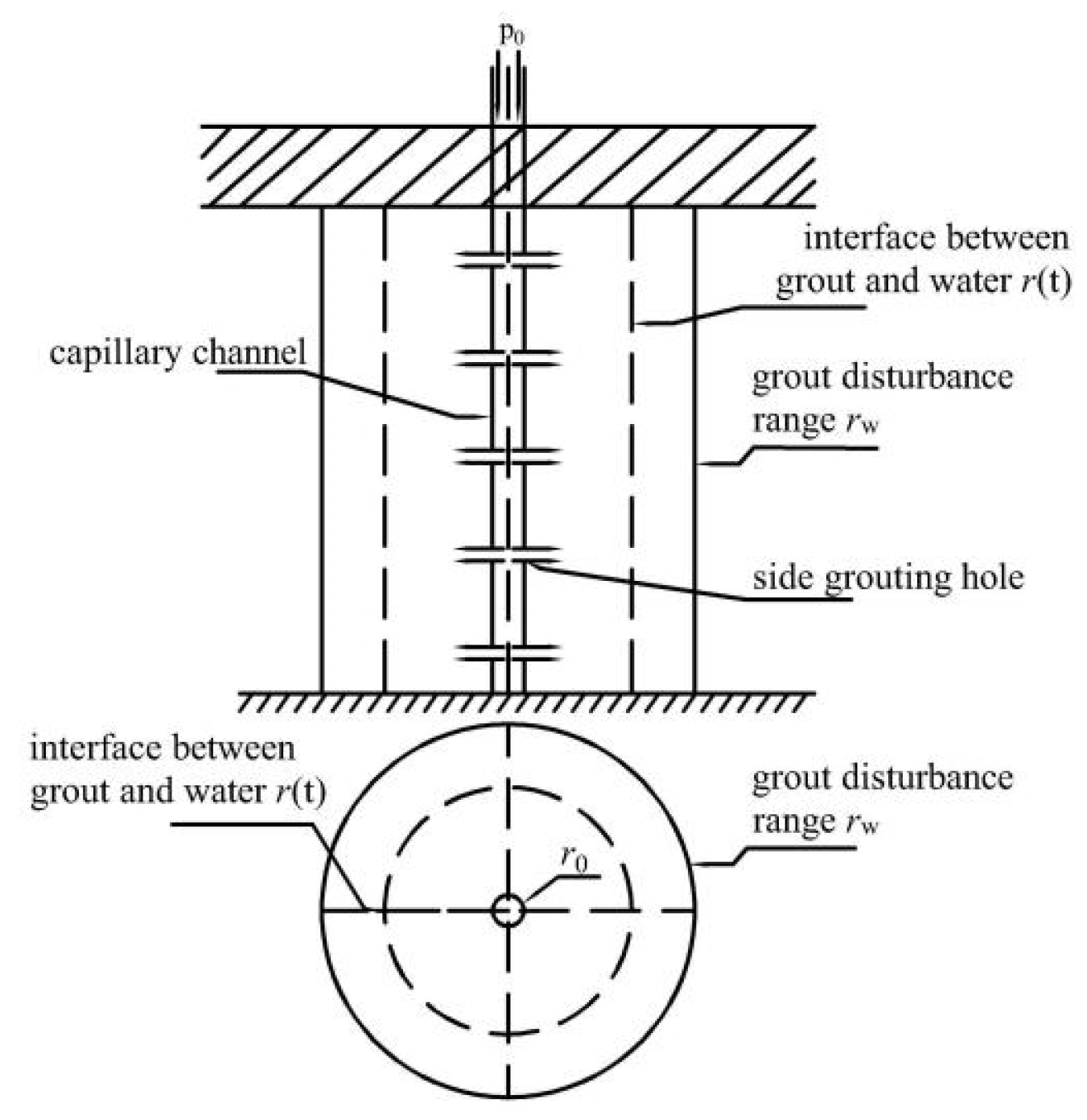

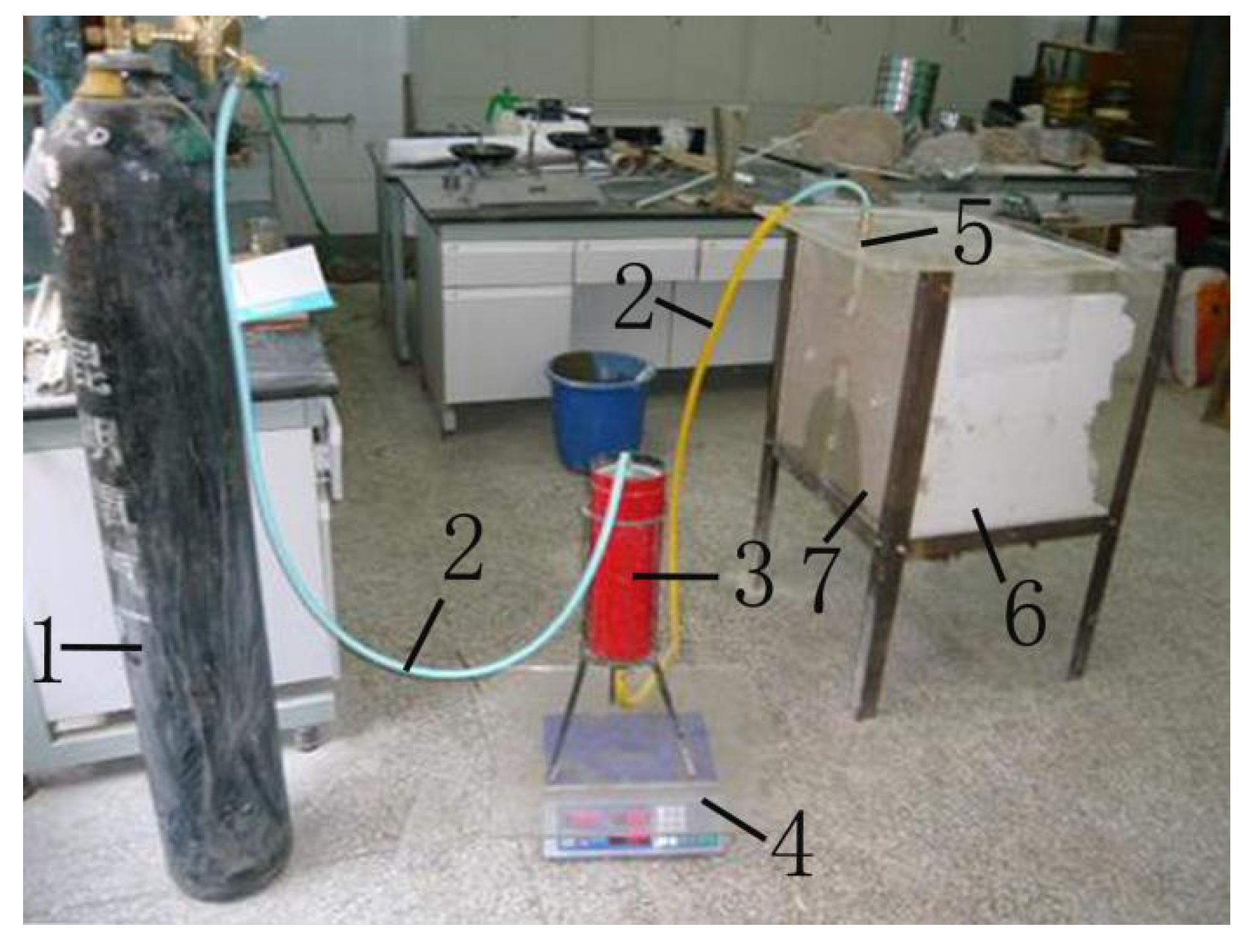

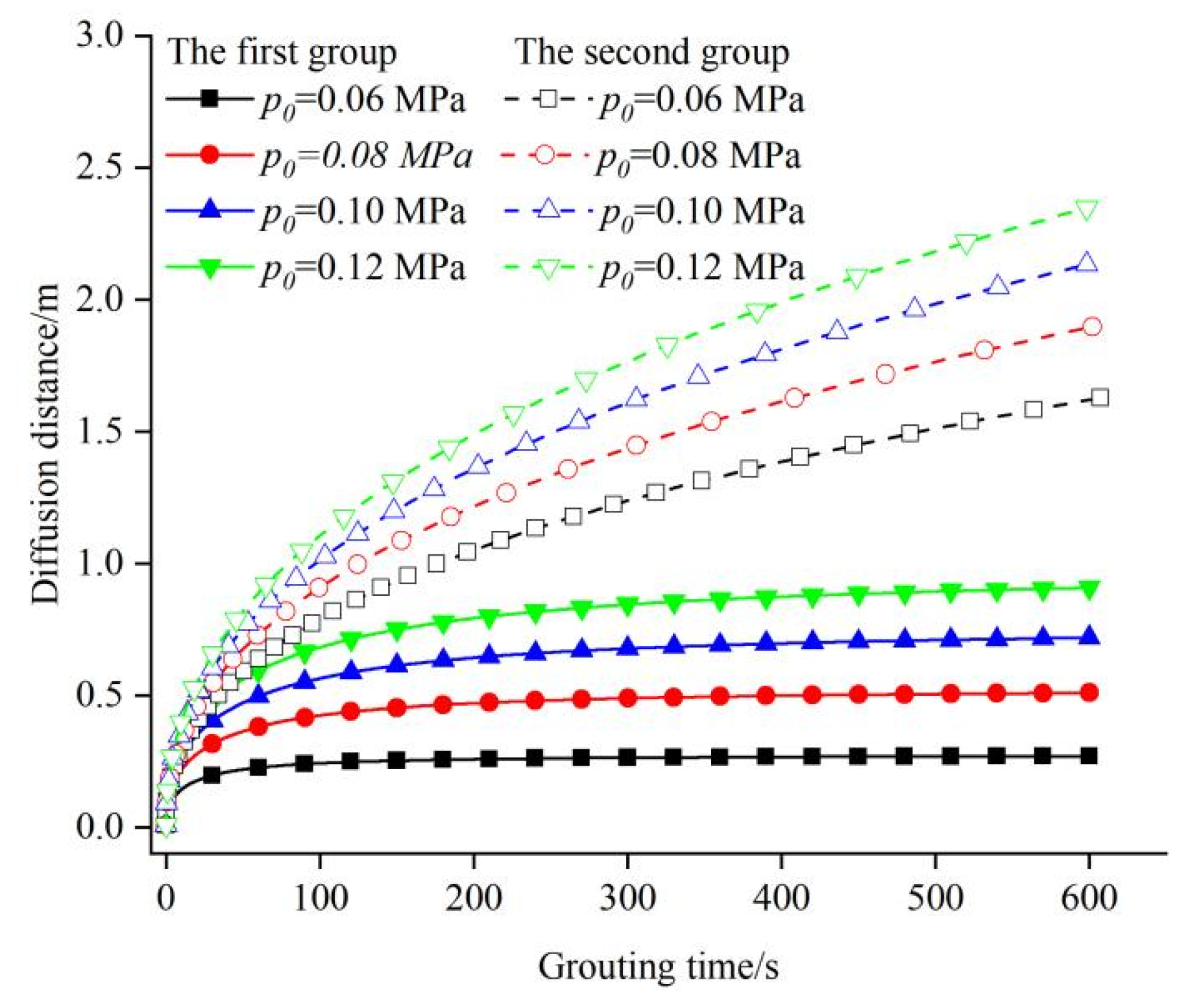

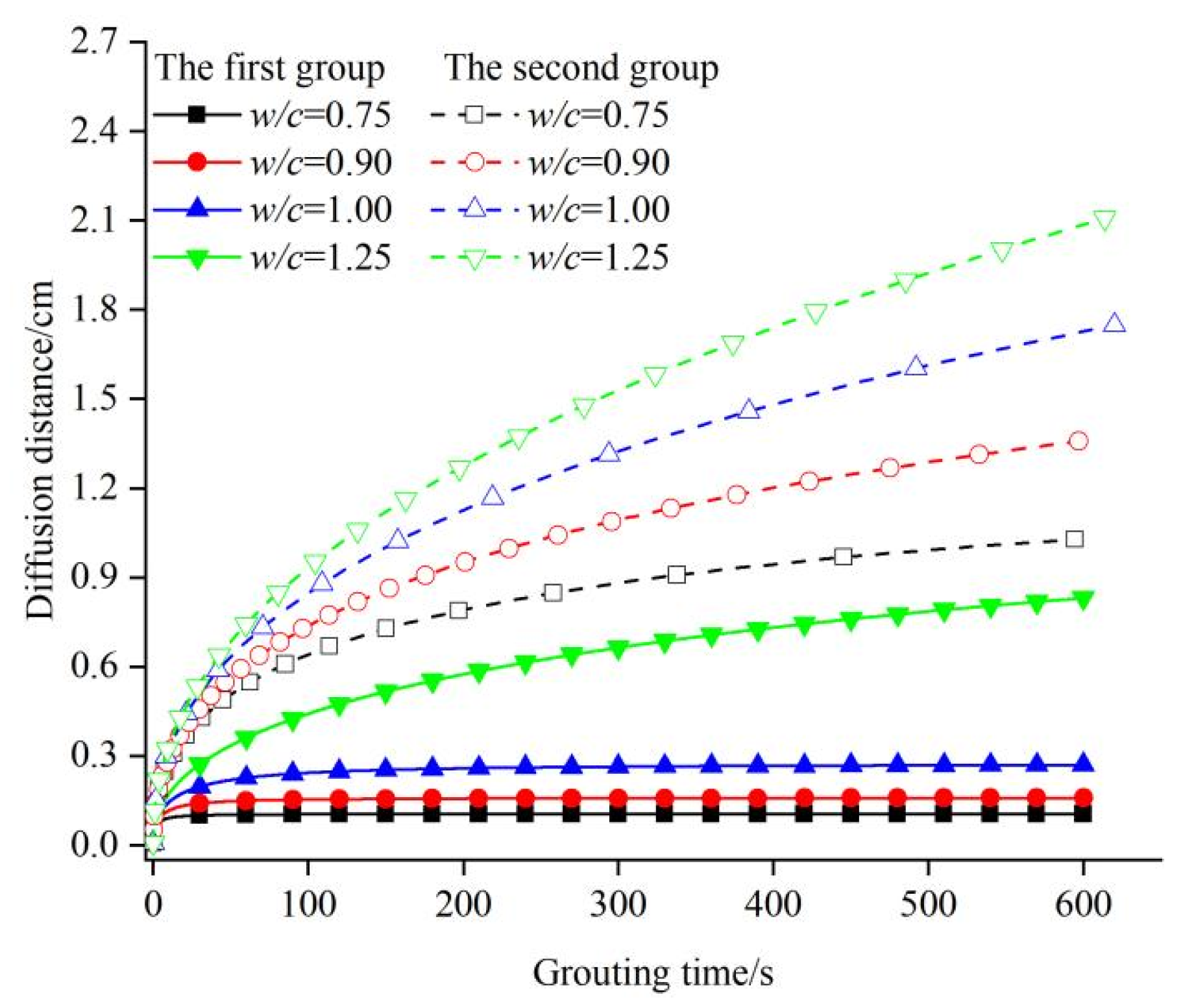
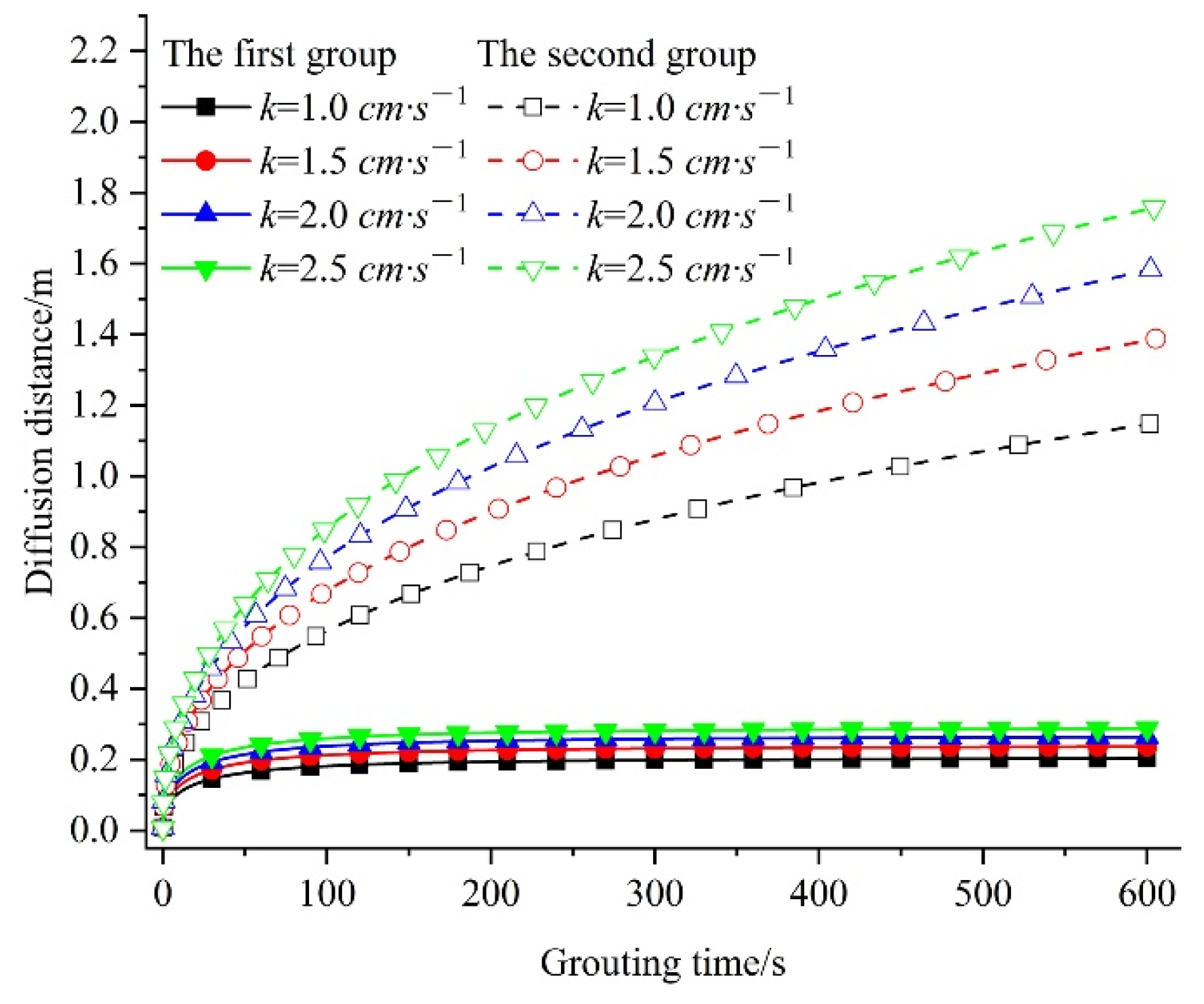

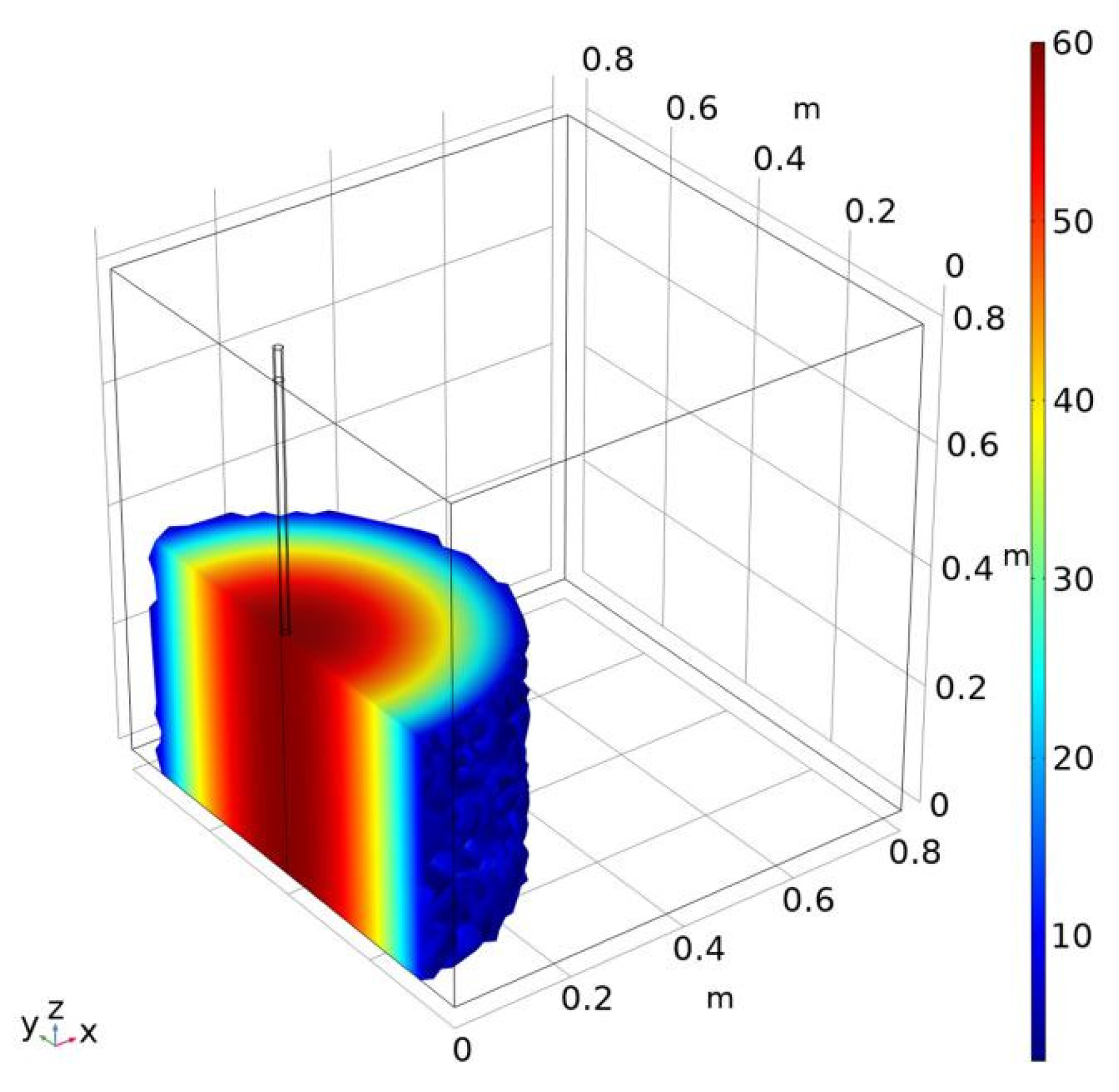
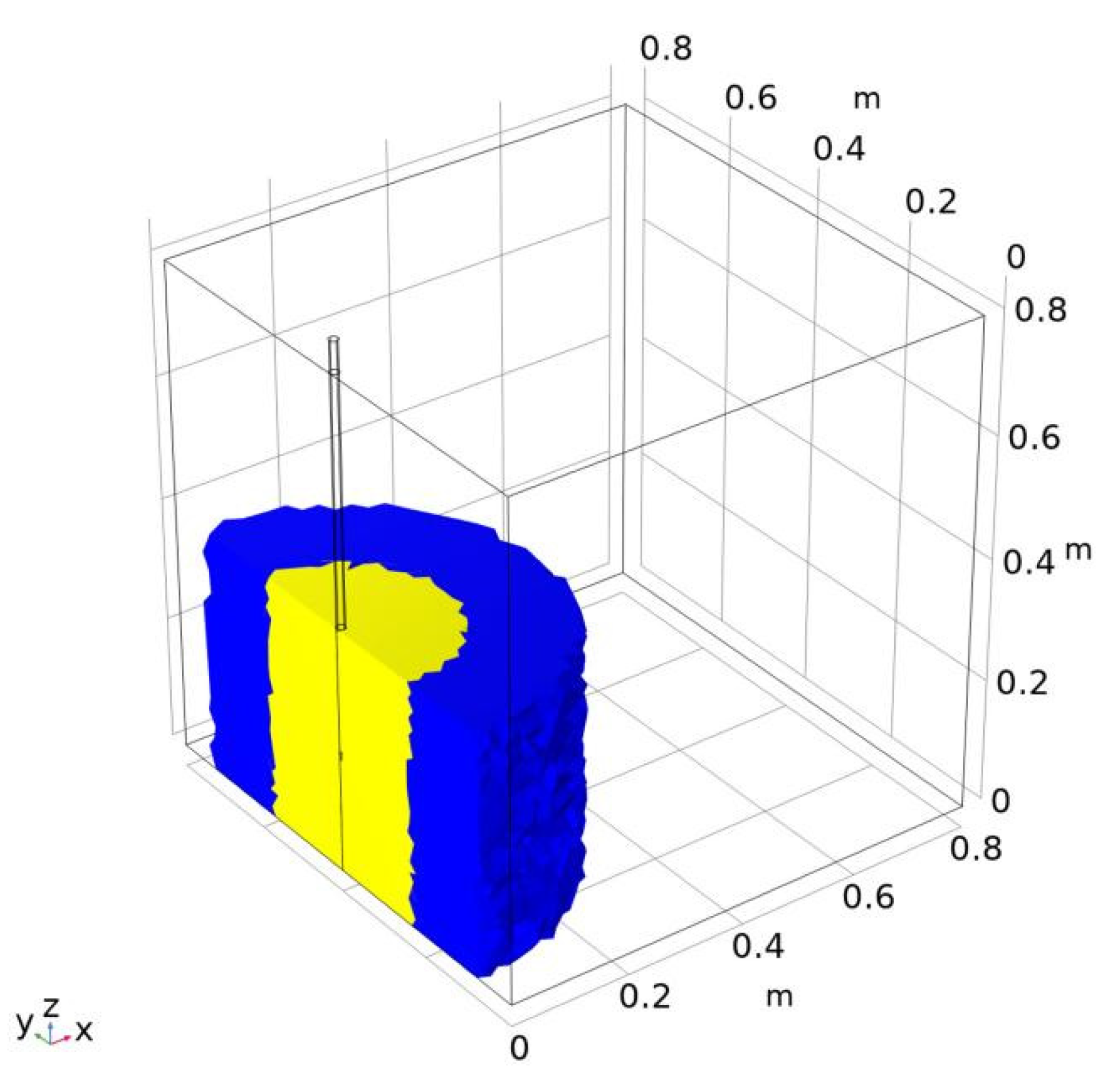
| Test Number | Water–Cement Ratio (w/c) | Grouting Pressure/MPa | Grouting Time/s | Penetration Coefficient k/cm·s−1 | Porosity |
|---|---|---|---|---|---|
| G1 | 0.90 | 0.12 | 26.50 | 3.45 | 0.4519 |
| G2 | 1.00 | 0.10 | 24.90 | 3.09 | 0.4391 |
| G3 | 1.25 | 0.08 | 23.50 | 2.89 | 0.4414 |
| G4 | 1.00 | 0.05 | 22.50 | 3.90 | 0.4524 |
| G5 | 1.00 | 0.06 | 21.70 | 2.11 | 0.4505 |
| Water–Cement Ratio | Rheological Equation |
|---|---|
| 1.25 | τ = 0.1136 + 0.0159 γ |
| 1.00 | τ = 0.8593 + 0.0169 γ |
| 0.90 | τ = 1.7876 + 0.0194 γ |
| 0.75 | τ = 3.2130 + 0.0203 γ |
| Experimental Number | Theoretical Values Obtained from Equation (18)/cm | Theoretical Values Obtained by Equation (19)/cm | Experimental Value /cm |
|---|---|---|---|
| G1 | 34.2 | 64.83 | 11.10 |
| G2 | 29.74 | 58.20 | 11.70 |
| G3 | 25.66 | 49.74 | 12.50 |
| G4 | 23.52 | 44.63 | 11.80 |
| G5 | 18.15 | 35.89 | 10.80 |
Publisher’s Note: MDPI stays neutral with regard to jurisdictional claims in published maps and institutional affiliations. |
© 2022 by the authors. Licensee MDPI, Basel, Switzerland. This article is an open access article distributed under the terms and conditions of the Creative Commons Attribution (CC BY) license (https://creativecommons.org/licenses/by/4.0/).
Share and Cite
Yang, Z.; Zhang, D.; Li, C.; Zhang, Z.; Zhu, Y.; Yang, Y.; He, N.; Bai, X.; Xi, W.; He, D.; et al. Column Penetration and Diffusion Mechanism of Bingham Fluid Considering Displacement Effect. Appl. Sci. 2022, 12, 5362. https://doi.org/10.3390/app12115362
Yang Z, Zhang D, Li C, Zhang Z, Zhu Y, Yang Y, He N, Bai X, Xi W, He D, et al. Column Penetration and Diffusion Mechanism of Bingham Fluid Considering Displacement Effect. Applied Sciences. 2022; 12(11):5362. https://doi.org/10.3390/app12115362
Chicago/Turabian StyleYang, Zhiquan, Dan Zhang, Chaoyue Li, Zhiwei Zhang, Yingyan Zhu, Yi Yang, Na He, Xianfu Bai, Wenfei Xi, Deming He, and et al. 2022. "Column Penetration and Diffusion Mechanism of Bingham Fluid Considering Displacement Effect" Applied Sciences 12, no. 11: 5362. https://doi.org/10.3390/app12115362
APA StyleYang, Z., Zhang, D., Li, C., Zhang, Z., Zhu, Y., Yang, Y., He, N., Bai, X., Xi, W., He, D., Ding, Y., & Zhou, M. (2022). Column Penetration and Diffusion Mechanism of Bingham Fluid Considering Displacement Effect. Applied Sciences, 12(11), 5362. https://doi.org/10.3390/app12115362






